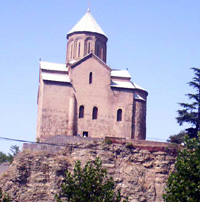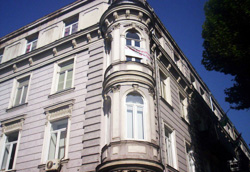Georgians divide their history in two parts: before and after the Revolution of Roses and often they call it before and after Sahakashvili. The positive change they mention after the revolution is that Georgian police officers no longer pull over cars on the streets.
This has made traffic easy on the streets and you will rarely see any police officers. However, if a driver makes a violation, the police officer appears out of nowhere and gives him a ticket. If the driver has a problem and stops in the middle of the street, the Georgian police officer is sure to help. Armenian tourists driving in Georgia are pleased to see that. The more civilized level of society claims that they have become more careful after Sahakashvili came to power and are afraid to express themselves freely. Georgian journalists say the same. They complain that the pro-Western president, with his democracy slogans isn’t in favor of freedom of speech. The Georgian authorities have almost complete control of the mass media. The former oppositional “Rustavi 2” television channel is now helping Sahakashvili’s PR. Georgians claim that the media was more liberal back in the days of Edward Shevardnadze. Besides that, Georgians complain that Sahakashvili is not fulfilling the promises he made before the elections, especially his promises to open factories and offer jobs. They also don’t like Sahakashvili’s foreign politics. Most Georgians are of the opinion that Sahakashvili shouldn’t go along with anything the U.S. says and hurt Georgian-Russian ties. Although most of them hate Russia, however they also don’t like the U.S. Georgians are becoming more and more anti-American, just like Armenians in Armenia are becoming more and more anti-Russian.
Post-soviet or post-revolution Georgia
 The first thing you notice as you walk the streets of Georgia is the ruins, the remains of the destructed factories, some bases. There’s even a half constructed building in the center of Tbilisi and that really portrays a bad image of the capital city. Sure, you can see the same ruins in Armenia too, but not as much as in Georgia. You can see the same beggars and trash-pickers on the streets of Tbilisi. It seems as though there is no life in the smaller cities. There are many cities in Georgia that were built on factories and other bases. After the collapse of the Soviet Union, those bases also collapsed and the region turned lifeless. There are no lands so that the people can at least take care of their expenses by produce. The local residents are either unemployed or trade. Life is getting better in the villages, where there is a bigger opportunity for farming.
The first thing you notice as you walk the streets of Georgia is the ruins, the remains of the destructed factories, some bases. There’s even a half constructed building in the center of Tbilisi and that really portrays a bad image of the capital city. Sure, you can see the same ruins in Armenia too, but not as much as in Georgia. You can see the same beggars and trash-pickers on the streets of Tbilisi. It seems as though there is no life in the smaller cities. There are many cities in Georgia that were built on factories and other bases. After the collapse of the Soviet Union, those bases also collapsed and the region turned lifeless. There are no lands so that the people can at least take care of their expenses by produce. The local residents are either unemployed or trade. Life is getting better in the villages, where there is a bigger opportunity for farming.
Georgia’s opportunities
In general, Georgia has a big opportunity to develop economy. First of all, it has transit roads and won’t face the danger of blockade like Armenia. Besides that, Georgia is surrounded by forests and rivers. It’s amazing to see that a country with these opportunities has a shortage of electricity. Georgia has a big opportunity to produce local electricity, especially hydro-energy. However, to this day they haven’t reopened the Inguri hydro-electric station. Despite its opportunities to develop ecotourism, Georgia isn’t doing anything. The main obstacle for ecotourism is the roads, but some transit roads are under reconstruction. The hotel business is not doing so well in Georgia. It’s hard to find somewhere to stay outside of Tbilisi. Of course, this doesn’t include the regions near the sea coast. The service of hotels in the capital city is low. But Georgians are proud of their nature. The deep forests in the outskirts of the city allow people to craft items out of wood. That will help solve the problems of people living in the regions. It seems as though the Georgian authorities aren’t doing anything about this either. The tourists coming to Georgia say that the Turks come to Georgia, cut down trees, take them, prepare furniture and then sell that to Georgians.
Beautiful Tbilisi
 Tbilisi, which is often considered the capital city of the Southern Caucasus region, is a comforting, beautiful city. Usually when you visit any capital city, especially when that is the capital city of the CIS countries or the Southern Caucasus, you try to draw parallels, compare and contrast with your city. From this perspective, Tbilisi is very different from Yerevan. First of all, you notice that Tbilisi has a history, the pre-revolutionary Tbilisi still exists. In contrast to Yerevan, the old buildings of historical/cultural significance remain standing in the central streets. Georgians are even surprised as to how it’s possible to destruct the old and create the new.
Tbilisi, which is often considered the capital city of the Southern Caucasus region, is a comforting, beautiful city. Usually when you visit any capital city, especially when that is the capital city of the CIS countries or the Southern Caucasus, you try to draw parallels, compare and contrast with your city. From this perspective, Tbilisi is very different from Yerevan. First of all, you notice that Tbilisi has a history, the pre-revolutionary Tbilisi still exists. In contrast to Yerevan, the old buildings of historical/cultural significance remain standing in the central streets. Georgians are even surprised as to how it’s possible to destruct the old and create the new.
You can safely walk the streets of Tbilisi and adore the city built on buildings of European taste. You won’t feel pressured by the traffic jams. It’s even surprising that there aren’t many cars in Georgia. You won’t even feel any pressure by the jam-packed apartment buildings, the nice stores and restaurants on almost every block. Trade centers are small here. The most interesting thing was that there weren’t any cafes in Tbilisi. Armenians make fun of Georgians by saying that they can’t offer people jobs. But when you take a look at how cruel Armenians become are when they work hard, you begin to think that Georgia’s unemployment is not that dangerous. Some buildings made of wood and painted with different colors still remain standing and add a little spice to Georgia’s capital city. In general, Tbilisi is very beautiful with its colors and architecture.
What also impressed me was how religious Georgians are. I must say that Georgian churches are beautiful and you can see a cross-stone and dome in every church. You can see people getting blessed as you pass by the churches. You won’t see anything like that in Armenia. It seems like their religiousness doesn’t even sense the difference between eating and making toasts. You don’t quite know whether it’s the fear of God or tranquility that the Georgians live the way they do. Perhaps the city is like that due to the people. In any case, as the Armenian visits Tbilisi, he feels sorry that there is no longer the old Yerevan.

